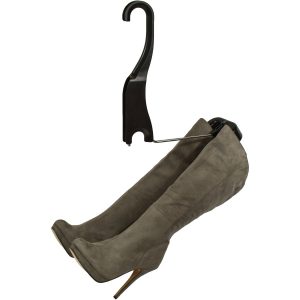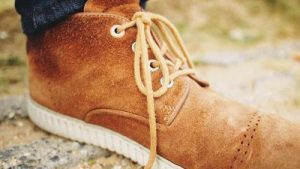 Suede is a beautiful, unique material. It’s always in style and an elegant wardrobe staple. It’s also a more delicate material, as it’s made from the soft, interior layer of hiding. That’s what makes suede special but also makes suede care a bit more involved. Suede can be easier to stain than leather, and it’s also more prone to scuffs.
Suede is a beautiful, unique material. It’s always in style and an elegant wardrobe staple. It’s also a more delicate material, as it’s made from the soft, interior layer of hiding. That’s what makes suede special but also makes suede care a bit more involved. Suede can be easier to stain than leather, and it’s also more prone to scuffs.
If you’ve just invested in a new pair of suede loafers (blue or otherwise) or a beautiful bag — or are looking to breathe some new life into suede that’s gotten stained, dirty, or is looking a little shabby because of everyday wear and tear — you’ve come to the right place.
We’ll walk you through how to clean, protect, wear and store your suede.
1. CLEAN YOUR SUEDE
Suede has a characteristically nappy finish. That’s a result of a combination of how the material is finished, and also the part of the hide that is used. Suede is more pliable than leather, and it’s also softer to the touch. And it’s suede’s textured finish that makes it more prone to scuffs and dirt.
The first thing we’ll deal with is the nap. We want to work it up because that’s suede’s natural state. (If the nap on your suede is lying flat and listless, you’ll be able to see a nice difference once you begin working up the nap.)
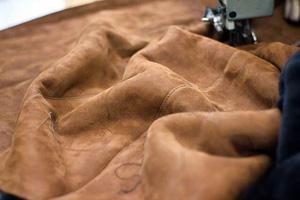 There are numerous ways to do this: You can use an old (clean) toothbrush, a hand towel, even very fine sandpaper. You can also invest in a suede brush, which is specially made just for this task. They aren’t expensive, so if you have lots of suede shoes and bags, or are really into a particular pair of amazing suede shoes, this type of brush (also called a nubuck brush) is a great thing to have. Rub the suede firmly back and forth; how long and how
There are numerous ways to do this: You can use an old (clean) toothbrush, a hand towel, even very fine sandpaper. You can also invest in a suede brush, which is specially made just for this task. They aren’t expensive, so if you have lots of suede shoes and bags, or are really into a particular pair of amazing suede shoes, this type of brush (also called a nubuck brush) is a great thing to have. Rub the suede firmly back and forth; how long and how 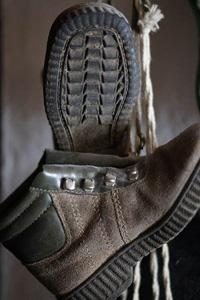 firmly will depend on what state the suede is in.
firmly will depend on what state the suede is in.
This step will loosen and get rid of surface dirt and scuffs. Make sure to brush with the suede’s grain (and not against it). This’ll help avoid damaging the suede and get it looking lustrous.
If your suede is especially old and not responding to the above, you can try steaming it. Hold the item over a pot of boiling water (avoid getting your hands and fingers directly into that line of steam), and then rub or brush the nap.
Let’s deal with larger scuffs and dirt next. For dry stains (we’ll get stains caused by moisture in a bit), you can use a number of tools: a pencil eraser, a dry eraser, or, a suede eraser (again, if you’re into your suede, this is a nice thing to have; they’re not pricey). Rub gently at first, and add pressure depending on how much dirt has been ground into the suede. You’ll see the dirt transferring to the implement you’re using during this process.
Once the dry stains and scuffs are gone, go back to step one and rub/brush the suede’s nap in the spots that you’ve just been working on.
Let’s move on to wet stains. If your suede is wet right this second, cover the stain with paper towels, a clean cotton rag, or towel to soak up the moisture. Don’t rub the stain, because that will push the liquid into the material when what you need to happen is the exact opposite. Blot gently until there’s nothing left to blot, and let the item dry naturally. You can put newspaper or cotton rags into shoes as they’re drying so that they retain their shape.
 Now, you have a few options:
Now, you have a few options:
Mix up equal parts of white vinegar and water, and dab that solution onto a clean rag or towel. Gently tap at the stain so that the solution can work its magic. Let the shoes (or purse, or whatever you’re working on) dry naturally — meaning, keep it away from any direct heat sources. If you’re concerned about a vinegary smell, that’ll definitely fade over time, especially if you wear or set your shoes outside (avoid puddles, rain, and snow!).
If you have watermarks that are deeply set in, you can try gently spraying the entire item with water. Then, blot off the excess moisture, and the marks should blend right in with the rest of the suede.
Finally, if your suede is deeply dirty, let a professional take over. Check first to see whether your local dry cleaner has experience with treating suede so that your item gets the proper care.
2. PROTECT YOUR SUEDE
Once your suede is nice and clean, it’s time to protect it from the elements. Suede protector sprays will do just that. Read the instructions and follow them carefully. When spraying your suede, do so with a gentle hand and evenly across the entire item. Let the item dry naturally, and repeat if that’s what’s called for in the instructions.
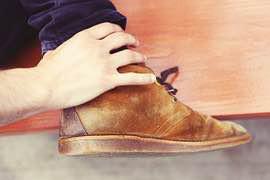 3. WEAR YOUR SUEDE
3. WEAR YOUR SUEDE
If you’ve done the above steps, there’s no reason why you shouldn’t wear your suede in all sorts of weather. After all, suede shoes and boots are meant to be worn. Do take care to avoid soaking the suede completely, though.
Certain chemicals, such as those found in perfume and cologne, as well as hairspray, might harm suede, so avoid having your suede come into contact with them.
And put a layer of material between you and your suede: Wearing suede without socks or tights will allow sweat and oils to come into contact with the suede, which isn’t optimal.
4. STORE YOUR SUEDE
For everyday storage, keep your suede shoes, bags, clothes and outerwear in a dark, clean closet.
Suede boots and booties will do great on one of our Boot Butler Boot Racks: They’ll be cradled in an upright position, keeping the suede crease-free.
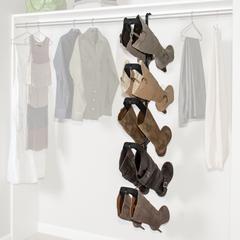 For longer-term storage:
For longer-term storage:
Suede’s delicate nature means it’s best stored in the dark: Take care to store your suede items in dry places, as moisture and even worse — mildew — is not suede’s friend. You can wrap items in natural fibers, such as old t-shirts or towels, or white paper. Don’t wrap suede with newspaper, as the ink might transfer out onto the material.
5. ENJOY YOUR SUEDE
Now that you’ve made it clean and gorgeous again, enjoy that suede!

